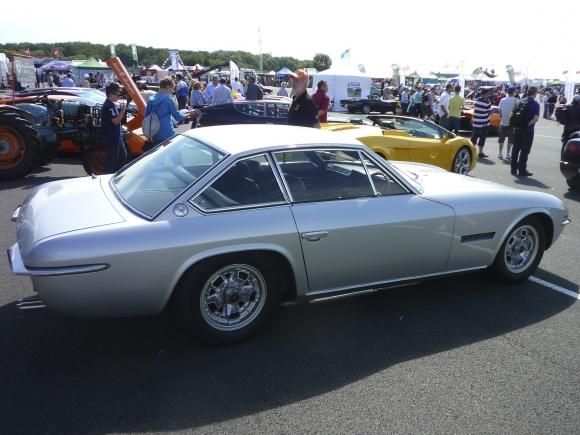Is a largely forgotten Sixties Lamborghini actually one of their best cars?
It probably hasn't escaped your notice that Lamborghini have been celebrating their 50th anniversary this year. I'll be honest: I'm not much of a Lamborghini fan. Most of their offerings are just too ostentatious for my taste. The Countach, Diablo, Murcialago and Aventador are just too outlandish, a fact not helped by many owner's desires to add big wings and garish paint schemes into the mix.
I will admit that the Miura is a truly beautiful car, especially in later SV trim, but it has a horrible driving position and the inherent design fault that means the car can spontaneously combust any time the engine is running rather puts me off! No, my favourite Lambo is not the Miura, but actually a car that almost completely eschews the traits everyone thinks about when discussing Lamborghini and as a result is largely forgotten today: the Islero.
The Islero story begins with the very first Lamborghini, the 350GT, a high-speed GT car which was built with the sole design ambition to be a better car than any road car Ferrari offered at the time. This two-seat GT was styled by the famous Carrozzeria Touring, also responsible for the DB4-6 Aston Martins. In fact, the 350GT slightly resembled the Astons, particularly in the glasshouse. Under the Superleggera bodywork the 350GT had the now legendary four-cam V12 attributed to Giotto Bizzarrini (although there is some suspicion that Honda had a hand in it), and independent rear suspension, making the Islero more technically advanced than any roadgoing Ferrari of the time, which were still using live rear axles and two-cam V12s.
The 350GT rapidly grew into the similarly styled but larger 400GT, which offered 2+2 seating and an engine that grew from 3.5 to 4.0 litres. Production ran through to 1968, although by this time Touring had gone bankrupt.
In order to update the 400GT to the Islero GT, Lamborghini turned to Carrozzeria Marazzi which had been formed by former employees of Touring. Marazzi reskinned the 400GT to give it a look more suited to the late Sixties and modern contemporaries like the Maserati Ghibli. Unusually, Marazzi gave the car a three-box saloon-style shape rather than the more traditional fastback style associated with most of the other cars of the era. That said, the Ferrari 365GTC, perhaps the Islero's most natural rival, also offered a notch shape. The most significant engineering change from the 400GT was that the track was widened to accommodate bigger wheels and tyres.

Launched in March of 1968, the Islero 400GT (to give it its full title) was not a sales success. Lamborghini's customers appeared to want the ostentation of the Miura and the equally outlandish Espada 4-seater that joined the range shortly after the Islero. After a little over a year and with 125 units built, the Islero received quite a number of updates to create the Islero 400 GTS. Power was increased from 325 to 350bhp in line with the changes the Miura had received in creating the Miura S. Styling-wise, the GTS had slightly flared wheel arches, a larger bonnet vent and quarter lights in the windows. Internally, a new and improved dashboard was used. It is also said that build quality was much improved. The GTS was no more successful than the earlier car and after a further 100 units the Islero was quietly dropped rather than re-engineered to meet tightening US regulations.

There was however one significant fan of the Islero: the company's founder, Ferruccio Lamborghini. He used one as his personal transport and it is said that the Islero was the car closest to what he originally conceived Lamborghini to be, as a builder of high speed gentleman's expresses rather than impractical supercars. He used his Islero regularly for high speed commuting around Lamborghini's five tractor, air conditioning and gas heater factories dotted around Italy. Gooding & Co has Ferruccio Lamborghini's Islero consigned to its Monterey auction.
The Islero is perhaps the ultimate example of Ferruccio Lamborghini's vision for the car company. It was as technically advanced as any Ferrari on the road (although Ferrari could now match the technical spec with the 275GTB4 and Daytona), and with its subtle styling was a car for the connoisseur rather than the extrovert. The Jarama that followed it was heavier and slower and did not really move the game along. It fared no better in the the marketplace, and in fact, combined sales of the 350GT, 400GT, Islero and Jarama added up to less than 1,000 cars. Financial troubles within Lamborghini's wider manufacturing group forced Ferruccio Lamborghini into selling the car division in 1972, and subsequent owners of the company have concentrated on the wild supercars rather than the subtle GTs. I feel that's a shame, but perhaps current owners Audi will one day see fit to create a modern replacement for the Islero.
Today you will seldom see much about the Islero in the classic car press, and due to their low numbers they are seldom openly advertised. When they are, the best examples can fetch over £140,000, with the later GTS having a price premium. This sounds like a lot but is barely a fifth of what its contemporary rival the 365GTC can expect to achieve. Those in the know say they drive better than their Ferrari rival, which itself is one of the best Sixties Ferraris to drive. I would love to have a drive in one and if you're reading this and are lucky enough to own an Islero (in the UK) and fancy a comparison with the Drive Cult Daytona or want to contribute your own thoughts on the Islero then do please get in touch!

